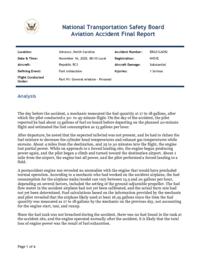
ASN Wikibase Occurrence # 244945
This information is added by users of ASN. Neither ASN nor the Flight Safety Foundation are responsible for the completeness or correctness of this information.
If you feel this information is incomplete or incorrect, you can submit corrected information.
| Date: | Monday 16 November 2020 |
| Time: | 09:10 LT |
| Type: |  Republic RC-3 Seabee |
| Owner/operator: | Private |
| Registration: | N451E |
| MSN: | 182 |
| Year of manufacture: | 1946 |
| Engine model: | Franklin 6A8-215-B6F |
| Fatalities: | Fatalities: 0 / Occupants: 1 |
| Aircraft damage: | Substantial |
| Category: | Accident |
| Location: | Davie County, south of Twin Lakes Airport (8A7), Mocksville, NC -
 United States of America United States of America
|
| Phase: | Landing |
| Nature: | Private |
| Departure airport: | Catawba, NC (NC26) |
| Mocksville, NC (8A7) | |
| Investigating agency: | NTSB |
| Confidence Rating: |
The day before the accident, a mechanic measured the fuel quantity at 17 to 18 gallons, after which the pilot conducted a 30- to 45-minute flight. On the day of the accident, the pilot reported he had about 13 gallons of fuel on board before departing on the planned 20-minute flight and estimated the fuel consumption as 13 gallons per hour.
After departure, he noted that the expected tailwind was not present, and he had to richen the fuel mixture to decrease the cylinder head temperatures and exhaust gas temperatures while enroute. About 4 miles from the destination, and 25 to 30 minutes into the flight, the engine lost partial power. While on approach to a forced landing site, the engine began producing power again, and the pilot began a climb and turned toward the destination airport. About 1 mile from the airport, the engine lost all power, and the pilot performed a forced landing to a field.
A postaccident engine run revealed no anomalies with the engine that would have precluded normal operation. According to a mechanic who had worked on the accident airplane, the fuel consumption for the airplane make/model can vary between 13.5 and 20 gallons per hour, depending on several factors, included the setting of the ground-adjustable propeller. The fuel flow meter in the accident airplane had not yet been calibrated, and the actual burn rate had not yet been determined. Fuel calculations based on the information provided by the mechanic and pilot revealed that the airplane likely used at least 16.25 gallons since the time the fuel quantity was measured as 17 to 18 gallons by the mechanic on the previous day, not accounting for the engine start, taxi, and runup.
Since the fuel tank was not breached during the accident, there was no fuel found in the tank at the accident site, and the engine operated normally after the accident, it is likely that the total loss of engine power was the result of fuel exhaustion.
Probable Cause: The pilot's inadequate preflight fuel planning, which resulted in a total loss of engine power due to fuel exhaustion.
Accident investigation:
 |
|
Sources:
NTSB ERA21LA042
FAA register: https://registry.faa.gov/aircraftinquiry/Search/NNumberResult
Location
Revision history:
| Date/time | Contributor | Updates |
|---|---|---|
| 16-Nov-2020 20:16 | Geno | Added |
| 14-Oct-2022 12:34 | ASN Update Bot | Updated [Time, Other fatalities, Nature, Departure airport, Destination airport, Source, Damage, Narrative, Category, Accident report] |
Corrections or additions? ... Edit this accident description
The Aviation Safety Network is an exclusive service provided by:


 ©2024 Flight Safety Foundation
©2024 Flight Safety Foundation